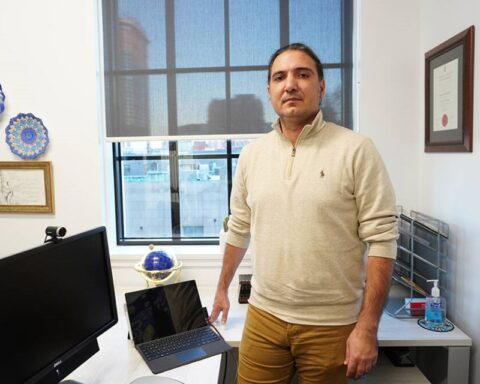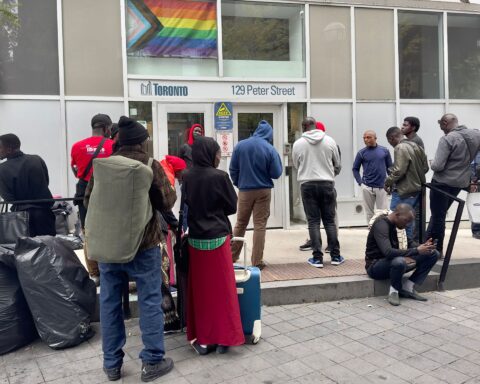Richmond community members came together last week to discuss breaking down the barriers of racism as part of the Canadian Race Relations Foundation’s (CRRF) three-year Our Canada Project.
Held at the John M.S. Lecky UBC Boathouse, the Living Together symposium featured guest speakers and guided public discussions aimed at building a more inclusive community.
Local member of Parliament for the riding Steveston-Richmond East, Joe Peschisolido, spoke about the role of society and government to mitigate conflicts and bring people of all different backgrounds together. Richmond’s acting mayor Bill McNulty highlighted the city’s diverse historical roots, including its First Nations, Japanese, Chinese and European influences.
One of the panel discussions, moderated by Robert Daum, Simon Fraser University (SFU) fellow in diversity and innovation, focused on the forces that shape Canadian identity.
“We keep using the word immigrant in a way that says some people belong more than others who arrived here on this territory, [when instead] we are all guests on Indigenous land,” stated Henry Yu, history professor and principal of St. John’s College at the University of British Columbia (UBC), during the panel.
“We keep using the word immigrant in a way that says some people belong more than others who arrived here on this territory.”
Yu explained that early Europeans in Canada were called settlers, while people from other countries are called immigrants.
Bringing people together
Dr. Kanwal Singh Neel, program coordinator of the Friends of Simon tutoring program in the faculty of education at SFU, added that many people want to feel a sense of belonging in Canada, while preserving their native language and culture.
Neel said sporting events like Vancouver Canucks’ hockey games and the Vancouver 2010 Winter Olympics bring people together.
Elaine Chau, an associate producer for the Canadian Broadcasting Corporation (CBC) program “The Early Edition”, said the sharing of food builds a sense of belonging and community.
“When we look at what we eat, even something as simple as rice pops up in every culture.”
“When we look at what we eat, even something as simple as rice pops up in every culture,” said Chau. “There are so many ways to relate around the dinner table that we can celebrate our differences.”
Addressing underlying tensions
When asked what challenges Richmond faces in creating inclusive communities, Chau said the issue of Chinese-language-only signs is more about the tensions “bubbling underneath,” because people she spoke with felt they were not welcome in Chinese shopping areas.
“People need to think about what can be done to make people want to venture into places that look unfamiliar,” she said.
Yu added that people should examine what’s causing the hurt feelings underlying the issue of Chinese-language-only signs and focus on building reciprocal relationships.
Metis writer and arts activist, Joanne Arnott, said the arts can be used to accomplish this goal and share culture. She drew on examples like a multilingual art project she led, as well as local poetry gatherings, which she explained encapsulate a person’s rich roots and emotions.
“How can we overcome these challenges? Through dialogue, through telling stories that create empathy.”
In regards to the question about how to address xenophobia and racism in the wake of the Canadian government’s decision to accept 25,000 Syrian refugees this year, Yu encouraged people not to isolate themselves from those they fear.
“How can we overcome these challenges? Through dialogue, through telling stories that create empathy so we understand, ‘Who are these people, what are their hopes and dreams?’” said Yu.
He said the picture of drowned Syrian boy Aylan Kurdi was powerful because it changed people’s feelings towards refugees.
Neel highlighted the importance of dialogue by using the example of the speculation that resulted over recent media coverage of three men taking ‘suspicious’ photos in the Pacific Centre mall, who the police described as looking ‘Middle Eastern‘.
Social change takes hard work
Later in the symposium, Suresh Kurl shared an uplifting story about coming to Canada from India and Richmond resident Cecilia Point talked about the Musqueam Nation’s successful fight to preserve a burial ground. Their stories are included as part of the CRRF’s 150 Stories project.
The public also participated in roundtable discussion sessions to create a timeline of important events that have impacted the city and develop a plan to address 11 key issues including the growing wealth gap and housing costs.
About 100 members of the public attended the event including students, local First Nations representatives and politicians.
“Social change takes hard work on the part of many, many people,” said attendee Caroline Wong, reflecting on the day’s programming.
Other participants expressed hope that the collected feedback would be put into action.
Attendee Kanwarjit Sandhu said that people can ask for change, but “we have the power to change one thing, that is ourselves, our attitude.”




